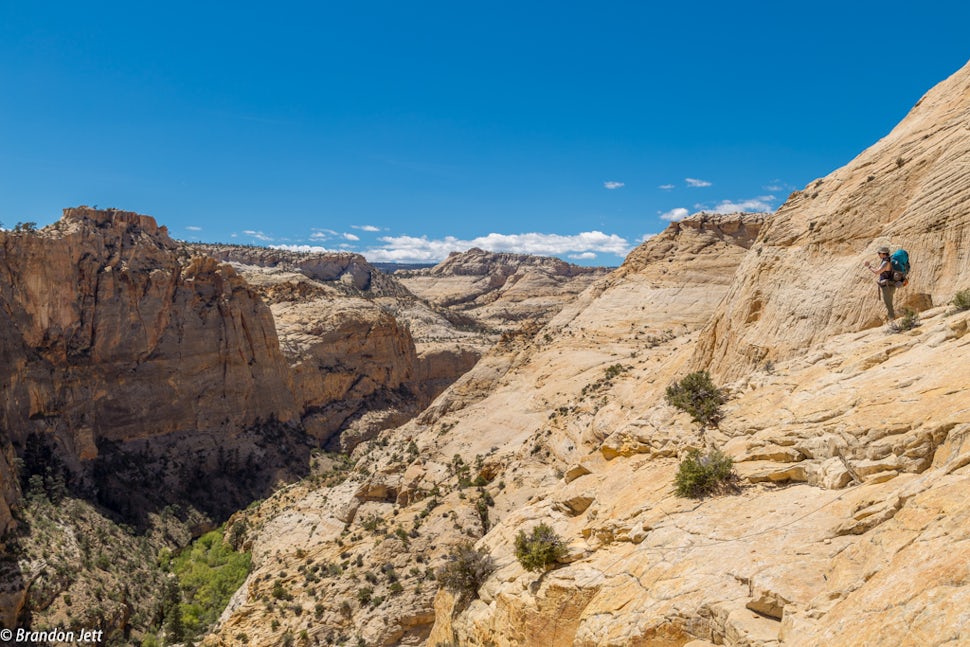Death Hollow - A Grand Staircase-Escalante National Monument Gem
The Grand Staircase-Escalante National Monument in Utah is 1.9 million acres of pure awesomeness. Death Hollow is just one gem tucked away in this slickrock paradise.

Epic views, mysterious and narrow canyons, rugged terrain, spring fed streams and rivers, swimming holes, cultural resources, and a geological and paleontological wonderland. This aptly describes the Grand Staircase-Escalante National Monument. Outdoor recreationalists, photographers, tourists, and lovers of all things wild flock to this area every year to visit this outdoor playground. This area, along with newly designated Bears Ears National Monument, is currently in the crosshairs of the anti-public lands movement in the west, and more specifically Utah. A handful of politicians would like to reduce the size or remove the designation altogether, taking away protections of these wild and sacred places. This would be a travesty. Help Keep Public Lands in Public Hands.
Death Hollow is a special place. We all have that place, that familiar escape where we can go to disconnect, to recharge, to get back in touch with our soul. Where you feel comfortable and nothing else exists but the present. This is one of mine. I've made 4 trips through Death Hollow, some solo, spending days without seeing another person or at times showing friends one of southwest Utah's greatest hits. The drainage begins high up on the southern slopes of Boulder Mountain, cutting into the sandstone and creating a mini-Zionesque canyon. From Hells Backbone Road its 22 miles to the Highway 12 bridge over the Escalante River, the upper half mostly dry until you reach a set of narrows that require swimming and wading, possibly some climbing. From the Boulder Mail Trail access its much shorter, and less technical although not any less stunning. All of my trips have originated at the old Boulder airstrip and finished at the highway 12 bridge over the Escalante River. This hike requires a shuttle, although there are creative ways to see this area with one car. Some of the best views in the Monument can be found here, along with swimming holes, narrows, archaeology, solitude and prime campsites.
The trail winds along the junipers and scrub oak, slogging between sand and route finding over the undulating slickrock. Follow the cairns! After a dip in Sand Creek up and over you go, then before you are prepared Bam!...behold Death Hollow in all its glory.
Sand Creek hides many treasures. Evidence of ancient cultures that date back thousands of years.
The Boulder Mail Trail follows the old telegraph line between Boulder and Escalante, parts of which you can still see. It was used from 1910-1955. This was the last route in the country that used pack mules to deliver mail.
Once you reach the bottom of the canyon...after a slightly sketchy descent...you will find one of the finest camps around. Ponderosa Camp.
Huge Ponderosa Pines contrast with the slickrock and sand.
Basalt boulders from Boulder Mountain litter the canyon bottom
A steep scramble ascent on the Boulder Mail Trail puts you back on the slickrock path towards Mamie Creek
Mamie Creek Natural Bridge, a nice side hike and lunch stop
Typical Death Hollow between the Boulder Mail Trail and the narrows. Pools, slides, falls, narrows...some of canyon country's finest...
Eventually Death Hollow converges with the Escalante River. Typically, the flow of the creek is greater than that of the river.
In the spring the desert is a blooming bouquet of variety
The southeast corner of Utah protects the highest concentration of Ancestral Puebloan artifacts and rock art in the country. This is an inaccessible granary high on the cliff along the Escalante River.
Arch along the Escalante River on the hike out from Death Hollow
If you haven't visited any of Utah's National Monuments, put it on your bucket list. The fate of these special places isn't certain. Support the local communties, spend money when you're there, get involved or at least stay engaged in the issues affecting these places. Take pictures or video and share them, maybe the more people that know what's at stake the better chance we have of permanent protection. Keep it Wild!
"For unnumbered centuries of human history the wilderness has given way. The priority of industry has become dogma. Are we as yet sufficiently enlightened to realize that we must now challenge that dogma, or do without our wilderness? Do we realize that industry, which has been our good servant, might make a poor master?" -- Aldo Leopold
We want to acknowledge and thank the past, present, and future generations of all Native Nations and Indigenous Peoples whose ancestral lands we travel, explore, and play on. Always practice Leave No Trace ethics on your adventures and follow local regulations. Please explore responsibly!
Do you love the outdoors?
Yep, us too. That's why we send you the best local adventures, stories, and expert advice, right to your inbox.






























